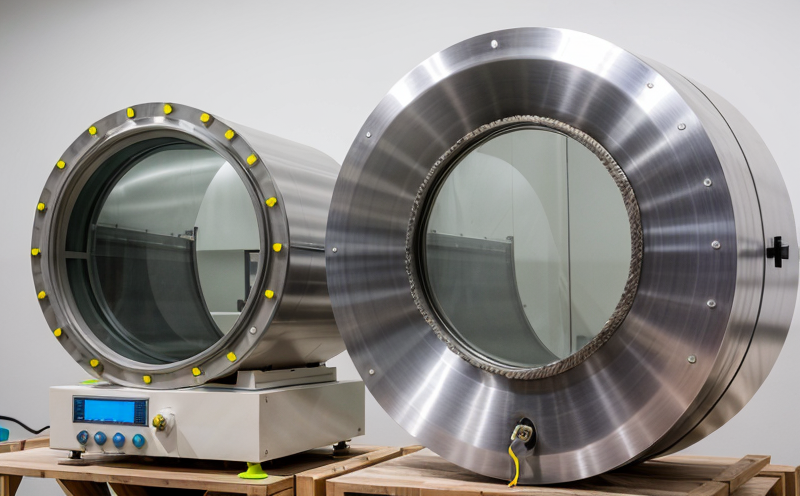ASTM C1838 Radiation Damage Resistance of Shielding Polymers
The ASTM C1838-20a standard test method is specifically designed to evaluate the radiation damage resistance properties of shielding polymers used in nuclear and radiation applications. This service plays a critical role in ensuring that materials used for radiation protection meet the stringent requirements set by regulatory bodies such as the Nuclear Regulatory Commission (NRC) and the International Atomic Energy Agency (IAEA).
The test method involves subjecting polymer specimens to high-energy gamma or electron beam irradiation, simulating real-world conditions. The primary purpose is to assess how well these polymers can withstand radiation damage without significant degradation of their mechanical properties, such as tensile strength and impact resistance.
ASTM C1838-20a is widely recognized for its relevance in the nuclear sector where materials must maintain integrity under prolonged exposure to ionizing radiation. It helps manufacturers ensure that the polymers they produce will perform reliably over extended periods without compromising safety or operational efficiency.
The testing process typically involves several key steps:
- Specimen Preparation: Polymer samples are cut into standard dimensions as per ASTM C1838 guidelines to ensure consistent test results.
- Irradiation: Specimens undergo irradiation using a gamma radiation source or electron beam, which simulates the high-energy conditions found in nuclear facilities.
- Post-Irradiation Testing: Following irradiation, samples are subjected to mechanical testing to measure changes in their physical properties. This includes tensile strength tests and impact resistance assessments.
- Data Analysis: Results from these tests are analyzed to determine the extent of radiation-induced damage compared to unirradiated control specimens.
ASTM C1838-20a is particularly valuable for R&D engineers who need to develop new materials that can withstand high levels of radiation without compromising performance. It also serves compliance officers responsible for ensuring product quality and safety meets regulatory standards.
The service provided here ensures accurate, reliable testing results that are essential for maintaining the integrity of radiation shielding materials used in various sectors including nuclear power plants, medical imaging equipment, and space exploration vehicles.
Applied Standards
The ASTM C1838-20a test method aligns closely with other international standards such as ISO 17654 and EN 13957. These standards provide a framework for evaluating the radiation resistance of materials used in nuclear applications, ensuring consistency across different testing environments.
By adhering to these standards, our service ensures that clients receive results that are both accurate and comparable with those obtained by other laboratories around the world. This is particularly important given the global nature of many industries operating within the nuclear sector.
Quality and Reliability Assurance
- Calibration and Maintenance: All testing equipment used in ASTM C1838-20a testing is regularly calibrated to ensure accuracy. This includes radiation sources, mechanical testers, and other instrumentation.
- Data Integrity: We maintain strict protocols for data collection and storage to ensure the integrity of all test results. These records are available for review upon request by clients or regulatory bodies.
- Repeatable Results: Our laboratory ensures that each test conducted follows the ASTM C1838-20a protocol closely, allowing for consistent and repeatable outcomes.
- Trained Personnel: All staff involved in ASTM C1838-20a testing are trained to the highest standards, ensuring they can interpret results accurately and provide valuable insights into material performance.
Our commitment to quality is reflected not only in our adherence to international standards but also through continuous improvement processes that enhance our testing capabilities further.
Use Cases and Application Examples
The ASTM C1838-20a test method finds application across various industries where radiation protection is crucial. Here are some specific use cases:
- Nuclear Power Plants: Ensuring that the materials used in reactor shielding can withstand prolonged exposure to high levels of gamma radiation.
- Medical Imaging Equipment: Evaluating the reliability of materials used in equipment like CT scanners and MRI machines, which are subject to significant radiation during operation.
- Satellite Manufacturing: Testing materials intended for use in space applications where exposure to cosmic rays is a concern.
- Defense Applications: Assessing the durability of materials used in military equipment exposed to intense radiation environments, such as those encountered by personnel during operations.
In each case, ASTM C1838-20a provides a critical tool for validating that the selected shielding polymers will perform as expected under operational conditions.





